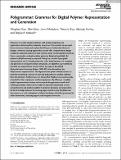Polygrammar: Grammar for Digital Polymer Representation and Generation
Author(s)
Guo, Minghao; Shou, Wan; Makatura, Liane; Erps, Timothy; Foshey, Michael; Matusik, Wojciech; ... Show more Show less
DownloadPublished version (4.547Mb)
Publisher with Creative Commons License
Publisher with Creative Commons License
Creative Commons Attribution
Terms of use
Metadata
Show full item recordAbstract
Polymers are widely studied materials with diverse properties and applications determined by molecular structures. It is essential to represent these structures clearly and explore the full space of achievable chemical designs. However, existing approaches cannot offer comprehensive design models for polymers because of their inherent scale and structural complexity. Here, a parametric, context-sensitive grammar designed specifically for polymers (PolyGrammar) is proposed. Using the symbolic hypergraph representation and 14 simple production rules, PolyGrammar can represent and generate all valid polyurethane structures. An algorithm is presented to translate any polyurethane structure from the popular Simplified Molecular-Input Line-entry System (SMILES) string format into the PolyGrammar representation. The representative power of PolyGrammar is tested by translating a dataset of over 600 polyurethane samples collected from the literature. Furthermore, it is shown that PolyGrammar can be easily extended to other copolymers and homopolymers. By offering a complete, explicit representation scheme and an explainable generative model with validity guarantees, PolyGrammar takes an essential step toward a more comprehensive and practical system for polymer discovery and exploration. As the first bridge between formal languages and chemistry, PolyGrammar also serves as a critical blueprint to inform the design of similar grammars for other chemistries, including organic and inorganic molecules.
Date issued
2022-06-09Department
Massachusetts Institute of Technology. Computer Science and Artificial Intelligence LaboratoryJournal
Advanced Science
Publisher
Wiley
Citation
Guo, Minghao, Shou, Wan, Makatura, Liane, Erps, Timothy, Foshey, Michael et al. 2022. "Polygrammar: Grammar for Digital Polymer Representation and Generation." Advanced Science.
Version: Final published version